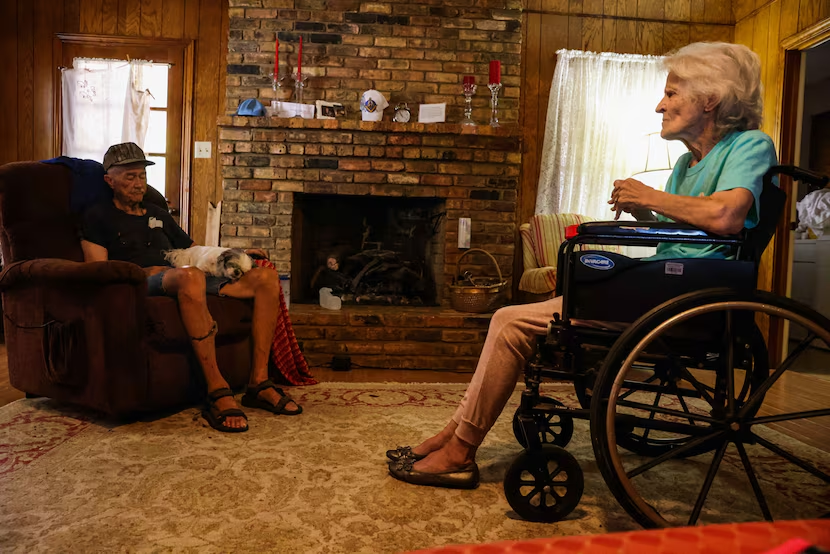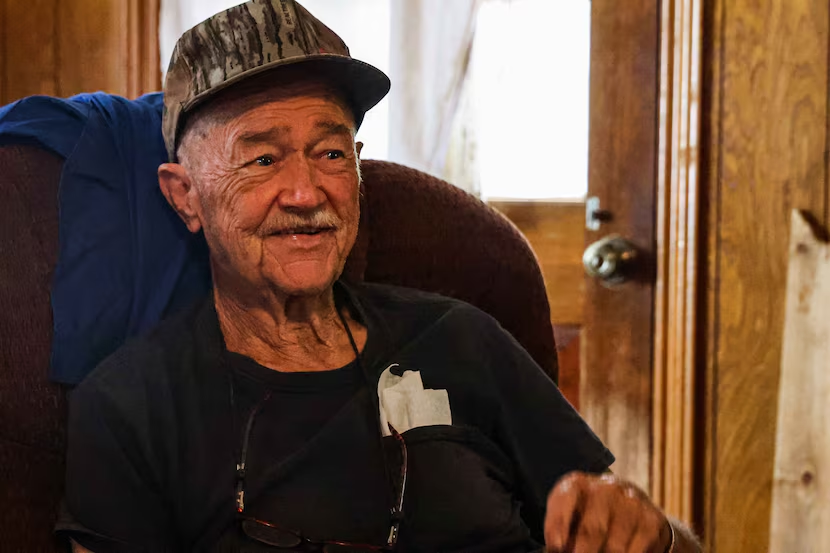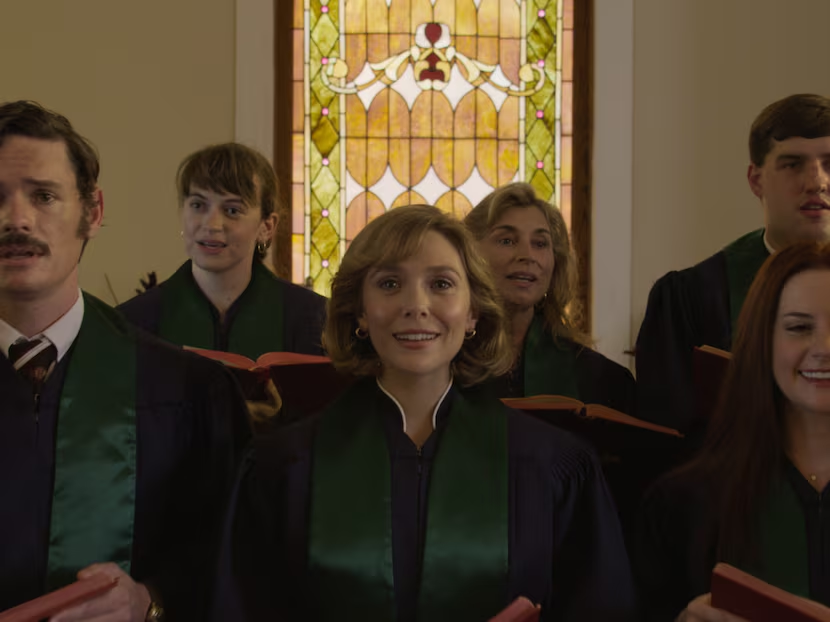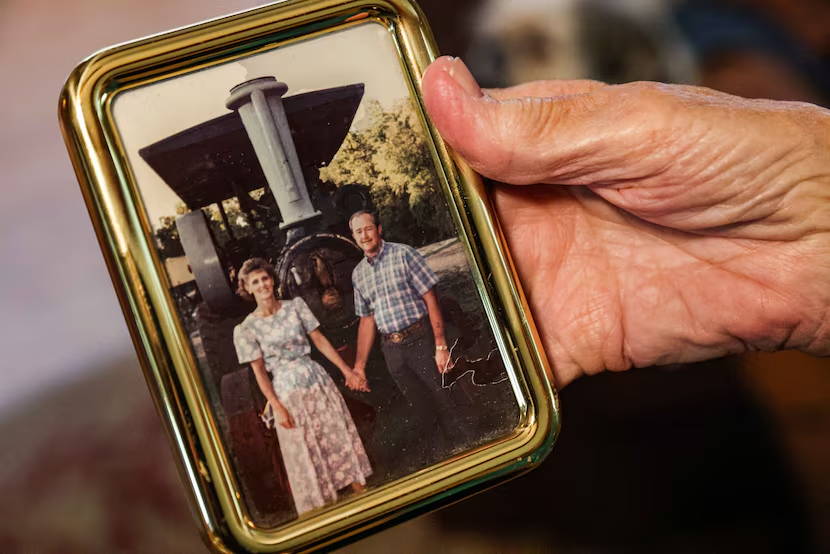Lester Gayler has one eye on his Shih Tzu, Prissi, as he recalls the day he found his neighbor’s body. While he speaks, the dog wanders across his yard, over to the neighbor’s mailbox, which is not quite out of view.
“Tell her to come back, Gayler,” says his wife, Bonnie, from her wheelchair in the doorway of the house. “I don’t want her to get in the street.”

“Well, she’s not getting in the street,” he reassures.
It was 41 years ago that Lester went to the house that sits in the corner of his eye now, knowing something was wrong. He and two neighbors tried a window and the side doors, but they wouldn’t budge. Then they tried the front door. And it opened.
“I went in first,” he says, sitting on his porch. “We went down the hall to the bathroom, turning on lights. A little old baby raised its head up out of the crib, out of the baby bed. It began to cry. It’d been there all, nearly all day, hadn’t been fed or nothing.”
Red footprints led to the utility room. “I opened the door,” he says, “and it was a bloody mess.”
A neighborhood altered
What he saw was Betty Gore, a fifth grade teacher at R.C. Dodd Middle School. The 30-year-old in pink shorts and a yellow T-shirt had been hit 41 times with an ax and was now lying in a pool of her own blood. Experts would later testify most of the blows came after she was already unconscious.
“There was ax marks up into the ceiling,” says Lester. “She’d broken in the walls,” he says of the killer. Out from under the washing machine peeked the weapon.

Lester, a longtime barber, is 82. He and Bonnie, one year younger, have stayed in the house next door to the killing ever since, except for the couple of years they lived in Richardson.
Soon after what happened, they left to stay with Lester’s brother in Nacogdoches, but they came back in two or three days. Wylie is where Lester’s grandfather had his farm, and where Lester was born and raised. “He was a big football player,” says Bonnie, and she was a drum majorette from Royse City back when they met in the ‘50s.
Today, the neighborhood, about 15 minutes from the Bush Turnpike, is quiet, with no outward hints of what happened. A pink toy car sits on the sidewalk. Fake tombstones stud one yard, and an inflatable ghost flaps in the wind ahead of Halloween.

“Back then, everybody — when it was reasonable — everybody pulled their windows open and would get that fresh air at nighttime,” says Lester. “And, boy, after that, the windows slammed shut.”
Deadbolts went up on doors that’d had none before.
“And then we found out it was a woman that did it all,” Bonnie says.
Roll camera
The woman, Candy Montgomery, is now the subject of not one but two major upcoming streaming series. Love and Death is on its way to HBO Max, and Candy to Hulu. This month, Kyle, Texas, outside Austin, has been the backdrop for HBO Max’s version, starring Elizabeth Olsen as Candy and Lily Rabe of American Horror Story as Betty. Nicole Kidman and David E. Kelley are producing.
Hulu’s project is in an earlier stage, with Jessica Biel, the ‘90s-early aughts TV star and wife of Justin Timberlake, as the killer.

They come after a 1984 book about the killing by Dallas journalists John Bloom and Jim Atkinson, a TV movie and a host of other segments about what happened four decades ago.
Everything about the case is eye-popping. In a small town northeast of Dallas, a 30-year-old housewife killed her friend with a 3-foot ax, hitting her almost four dozen times in the victim’s home on Friday the 13th in June 1980. There were no witnesses. The killer was 5 feet 4 and 120 pounds, smaller than the victim. She sang in a Lucas church choir with the woman she slayed. On the morning she did it, she was picking up a bathing suit for the victim’s daughter, with whom she had plans to spend the day.

Candy Montgomery had been in an affair with the victim’s husband, Allan Gore. Out of loneliness and boredom, she’d propositioned him after choir practice, according to Bloom and Atkinson’s book. She was careful with her words and her timing, not wanting to jeopardize the comfortable life she already had with her husband and two kids in Fairview.
At first Allan demurred, according to the book, but he came around. The two planned their lunchtime trysts at the Como Motel in Richardson with a precision that bordered on over-the-top. They were smart people who knew what they wanted and made plans to get it, he an engineer and she a fixture in her church. They’d take what they needed from each other — what their spouses and safe lives lacked — while being prudent enough not to get caught.
If anyone could do it, it was they. They made rules — they’d meet only once every two weeks; expenses would be split 50-50; if they ever got too close, it would end — but they broke them when they got attached.
Guilt caught up to Allan. His second child was born, another girl. He and Betty were patching things up, Bloom and Atkinson wrote. When he told Candy it might be time to part ways, she was hurt. It was a dramatic reversal. She was the one who’d held the cards at first, who’d laid out the rules and arranged their stays at the Como — which today still stands on Central Expressway.
At the Gore house in Wylie on the morning of June 13, Betty confronted Candy about the affair unexpectedly. It’d been over for months. Betty got the ax from the garage and came at Candy. Dogs barked outside. There was a struggle, and Candy won.
Candy washed up in Betty’s bathroom, according to reports. Then she slipped out the door, leaving the slain woman’s year-old baby alone in her crib. She drove back to Fairview and then to church. She picked up her kids — and Betty’s older daughter — as if nothing was wrong. Allan, away on a business trip, called the neighbors that night when his wife wouldn’t answer the phone. That’s when Lester found the body.

At trial, Candy’s defense took a bizarre legal angle to explain the mutilation that went far beyond self-defense. Something Betty said during the struggle with the ax triggered a repressed memory Candy had of her mother, and she reacted with unthinking rage, her lawyers argued. It worked and Candy was acquitted, despite the evident viciousness of the hacking. She left Texas and moved to Georgia, where she still lives.
“You tell people the barest facts and they go, ‘What?’” says Atkinson. But after years of retellings, including his and Bloom’s definitive one, what more is there to say? More than a generation has passed since the killing. Candy is gone. Property records show a young couple bought the Gore house last year. Many have never even heard the families’ names.
Now, two media giants with more than 100 million subscribers between them are competing to tell the story again. Why can’t we stop coming back to it?
Dead-end narratives
There’s the most obvious reason: It happened in a middle-class white community. Take the same facts — with all their brutality — and transpose them somewhere poorer and less racially homogeneous. Would there be a streaming series? Would it even have been front-page news?
Probably not. That’s something many would agree on now.
In fact, so much has changed in the 40 years since the case, we can’t understand it much the same way at all.
On the surface, it’s a female morality tale, and, sure, those grab interest, too. Cheat on your husband with no mind to the consequences and you’ll regret it. But to read it that way is to reduce its characters. Candy was savvy and powerful, at her church and in community life. The affair was a calculated risk, but she’d done the calculations.
“These were sophisticated people, young people, they were well educated,” says Atkinson. Many in their circle had technical jobs at the nearby electronics companies. “They were working in these industries that were about to, you know, rule the world. … They knew what they were doing, starting with Candy.”
In maybe the most outdated reading, the story is a case study in forensic psychology. Candy had a “dissociative reaction,” a Houston psychologist testified, triggering her rage. She couldn’t remember this, so he’d drawn it out of her under hypnosis.
But that idea doesn’t hold up either anymore. The issue: Hypnosis, at least the type Candy underwent in 1980, assumes our brains are like camcorders, filing things away faithfully to how they occurred.
“Since then,” says Holly Bowen, a professor in Southern Methodist University’s psychology department, “there’s been literally thousands of studies that have shown that’s just really not true. And on top of that, even if you have something in your memory, and you can recall it, it in no way means that it hasn’t been interfered with or modified in some way.”
As our thinking has evolved in four decades — around race, gender and the nature of our minds — retelling the story could even be dangerous now. The pitfalls are many. They’re filled with old archetypes and flawed beliefs, notions that nowadays live more in the rearview mirror than the headlights.
“There’s always been a risk with this story,” Atkinson says, “OK, it’s an ax murder. And they kind of, they go there and they stay there.”

Hulu and HBO Max said they wouldn’t discuss their projects yet in detail. Neither one has a release date.
Knowing what isn’t the story anymore, what is? Grasping for an answer, Atkinson zooms out from its main characters.
Nobody bore responsibility besides the killer.
“And yet,” he says, “there was this collective sense I always got in talking to people out there about it, that, that — shame is a good word. That they were ashamed this happened, and what do you do with things you’re ashamed of? Well, you kind of deny them. You put them away.”
With quiet intensity, it’s a reaction that lingers today.
‘Justice wasn’t served’
The trial took eight days and brought no moral resolution.
Collin County had just settled into its new courthouse the previous year, but the judge moved the proceedings to the old one on McKinney’s square. It sat about 200 but that still wasn’t enough. Every day crowds competed for seats. When Candy was acquitted, some yelled “Murderer!” as she walked to her car.
It was a shock at first when her lawyer, Don Crowder, a church friend, revealed she would plead self-defense. But through her own testimony and that of her psychiatrist, her defense team won over the jury, explaining away the excess of violence in a way that seemed impossible at the outset.
“I hit her. I hit her. I hit her,” Candy said, according to reports, weeping on the stand.
“I stood back and looked at myself and I was covered in blood. I felt so guilty, so dirty. I felt so ashamed.”
Crowder bent down and unwrapped something. It was the weapon, still bloody, reports said.
“You killed her with this ax?” he shouted, thrusting it in her face.
“Don’t make me look at it!” she screamed.
Juror Alice Doherty Rowley said the number of blows never entered into the verdict, since Candy, lawyers argued, was unaware of what she was doing as she chopped. “We determined it never had a bearing on the verdict at all — whether it was one gunshot or 1,000 whacks.”
Adultery was no factor either. “A lot of those people” — the courtroom spectators, she meant — “think she should have been convicted on a morals charge. But this woman wasn’t on trial for adultery.”
Ask Lester Gayler today, and it’s simple. “Justice wasn’t served,” he says.
A silence that speaks
The angriest people in 1980 were the loudest — they always are — but beneath all the shouting was a desire to just move on.
“If you listened to talk radio and all that at the time, there was: ‘Oh, she got away with murder!’ It was all this outrage,” Atkinson says. “But within that tightly knit community or series of communities out there,” he believes, “they were just as happy to have it be shoved back under the rug.”

Local media wasn’t making it easy. After wall-to-wall coverage of the trial, a Dallas Times Herald reporter knocked on Candy’s door for her reaction to the verdict. She answered, holding a kitchen knife. “Don’t worry, I’m not dangerous,” she said, smiling. Some stories were just too good to pass up.
Three months later, the press was back, standing on her lawn as she and her husband packed a moving van. She’d been hopeful at first to stay put, but it hadn’t worked out that way. “It will never completely vanish until she vanishes,” her lawyer, Crowder, said. It was quite an admission. Though his tactics were rough, he’d been her boldest advocate. But Crowder was as much a neighbor as everyone else. He knew the way the wind was blowing.
For all his vivid memories of discovering Betty’s body, Lester Gayler gets quiet when asked what he makes of the killing. He’s sitting in an armchair with the dog on his lap and a Christian TV program on mute. “We’ve always lived in a sinful world,” he says, “and it’s getting worse.”
These days, it seems nobody wants to talk about what happened. Next door, the former Gore house looks much like it did in 1980 from the street. But the blinds are closed and the Ring doorbell brings no answer.
Of the two other men who were in the house with Lester that night, only one, Richard Parker, picks up the phone. He lives in Wylie still, too. He doesn’t want to talk, but he offers a few words of reflection: “You think about a thing like that.”
Lester says his son, Adam, was out mowing the lawn on the morning of the killing, around the time Candy came by next door. Contacted for this story, he didn’t respond.
A call to Candy herself is answered by someone who says they are a relative but won’t give their name. Now in her 70s, Candy suffers from PTSD, the person says, “and the phone calls don’t help.”

Even those at the Como Motel in Richardson are hesitant to talk about the case. They certainly have had the opportunity. “You know, I’ve been here for 30 years,” says the motel’s manager, Alma Jordan, “and every day somebody comes and asks.”
That baffles Jordan, and for good reason. The Como is not where the killing happened. Sure, it’s where Candy met her victim’s husband for sex. (They also met at the Continental Inn, Jordan points out from behind the cashier’s window in the motel’s cramped office.) But it’s not where she swung the blade that killed his wife.
Jordan doesn’t know what to tell people. “Nothing happened here.”
Memories linger
If there was ever a moment when moving on from the killing seemed possible, it’s right now. Two generations have passed since it happened. No one under 40 watched it play out in the courtroom, in the newspapers or in the heads of their neighbors as they reckoned with its immediate aftermath. After we talk about the case, the Gaylers show me pictures of their grandkids, the oldest being young adults. I wonder if they even know what happened, what their parents’ parents saw.

For today’s true-crime-crazed producers, there’s a clear flip side. A fresh audience is here in bulk. When better to go big with a retelling? That they are about to — when perhaps it really could all be forgotten — is strong proof that it won’t. We’ve committed to this story, and it’s not going anywhere, even with time.
A block from the Gaylers’ house, three kids are playing catch with a baseball. Have they heard about what happened years ago up the road? Kind of, says one, but he’s fuzzy on the specifics. Do they know there are some TV shows coming soon, from some big names? Surprised, they burst out cheering. It’s crude, but who can blame them? They’re stunned.
“HBO and Hulu,” says one, wide-eyed, to his friend. It might’ve flickered for a minute, but the story won’t fade.
Staff researcher Spencer Bevis contributed to this report.


